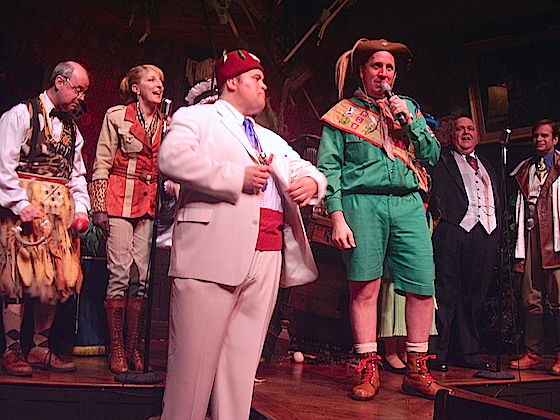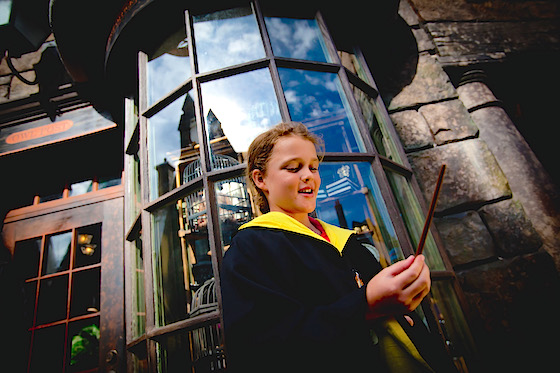The Adventurers Club wasn't simply a bar. It served as a stage for an ongoing interactive performance, where guests could join actors in improvising tales of travel and adventure around the world. The club was a bold experiment in what we now call LARP — live action role playing. The Adventurers Club's appeal wasn't necessarily to the gamers who today drive many LARP events around the world. The Adventurers Club appealed instead to the many theater geeks who worked at the Walt Disney World Resort and other area attractions, who adored this opportunity to have fun while stretching their improvisational skills. There was nothing to be "won" at the Adventurers Club but a smashing good time.

So why is this important, seven years after the club's demise? The Adventurers Club previewed a 21st-century vision for the themed entertainment industry — a model for themed entertainment that can compete successfully with high-definition home televisions and interactive online video and role-playing games. The Adventurers Club showed how a theme park can create an environment that gives fans something beyond riding the same rides and seeing the same shows — an opportunity to join an immersive narrative experience that changes with every moment.
I felt this as a child when I took the raft across the Rivers of America to Tom Sawyer Island. There, I could become part of Tom and Huck's gang, creating my own adventurers as I explored the island that Disney had created to fire my imagination. Millions of fans feel this today as they enter Universal's Wizarding World of Harry Potter, which even the stars of the Harry Potter films lauded as the most faithful expressions of Hogsmeade and Diagon Alley that they could envision.
Ultimately, these types of opportunities are what distinguish theme parks from amusement parks. They're not simply collections of attractions but themed environments that provide an opportunity for narrative immersion that extends beyond those moments when you're on a ride or in a show.
That's the magic that people feel when they walk through Sleeping Beauty or Cinderella Castle into Disney's Fantasylands, where they can not just imagine but actually feel themselves stepping into a fairy tale kingdom. On this simple level, theme park fans always have loved role playing. We've always welcomed these opportunities to immerse ourselves in another world. It's our chance to make the "once upon a time" now.
What the Adventurers Club did so well is create an opportunity for passionate theme park fans to take a few more steps up a ladder of engagement with its themed environment. Step inside, and most evenings you could count on one of the club's "characters" calling you into a conversation. You could play along and talk as yourself, but if you wanted to, you could try to match your host's stories with outrageous, and equally made-up, tales of your own. Some guests got so involved in the club's ongoing narrative that it became hard to tell who was a role-playing Disney cast member and who was just a role-playing fan.
If the Adventurer's Club failed in any aspect of providing an interactive environment for fans, it was in that the club might have skipped the first few rungs on that ladder of engagement. With its intimate environment and enthusiastic participants, the club was a bit too "in your face" for many Disney guests, who quickly retreated to Mannequin's or another Pleasure Island club where they could put back their first drinks in relative anonymity, to build some liquid courage before having to make up conversations with people they didn't know.
In a place such as Diagon Alley, you can walk through as a theme park fan, treating the land like any other — waiting for rides, eating in restaurants and browsing the shops. If you want to take it further, you can go ahead and buy an interactive wand then start casting spells at the designated windows. Or you can buy some house robes and sit down for a Butterbeer or Dragon Scale as if you were on break from term at Hogwarts. On any given day, Universal Orlando visitors likely will find others in full-on Potter role-playing, such as the local high school students who'd dress as Hogwarts students to do their homework at Three Broomsticks every afternoon. The ladder of engagement here is more accessible, gently leading people into greater involvement as their desire (and bank accounts) allow.

Of course, some people who take those first steps up the ladder will long for opportunities to move higher and higher, further engaging themselves in an interactive world. These are the challenge for theme park designers in the 21st century. How do you create not just new rides and shows, but new platforms upon which guests can become performers themselves? How do you create a ladder of engagement that invites new visitors to climb aboard without intimidating them to the point where they rush away? Then how do you create the ability to keep adding rungs to the top of that ladder, so that your most passionate, engaged fans never get bored and always find new ways to remain entertained by the world you've created?
It's much easier for designers to start with characters and environments that visitors already know, than to have to introduce a mythology from scratch. That's one of the reasons why we've seen a movement toward outside IP in themed attractions. If you're trying to build a sense of engagement, it just makes sense to begin with a property with which visitors already feel engaged. Harry Potter fans come to Universal Orlando already wanting to taste a Butterbeer. Universal simply needs to deliver that wish.
The great parks of the 21st century will not be the ones that offer bigger, faster, and wilder rides. Nor will they be the ones that find new ways to usher us from one passive viewing experience to the next. The best theme parks of the 21st century — the ones that will compete and win against other forms of technical entertainment — will be the ones that create irreplacable worlds that make us crave to visit.
Just like the Adventurers Club did.
What are some of your favorite immersive environments inside theme parks?
Next: How one major theme park company is undercutting its efforts to create themed environments.
Tweet
Role playing environments are fine as entertainment. The problem is they need to refine it and constantly update it. The Adventurers Club's flaw was its consistency. Plus, the club reminds me of a real stuffy club. It's like they are ghosts. Sort of like the movie "The Others" or "The 6th Sense". They are dead. They just don't know it.
Which is exactly why so many people - mostly current or ex-cast members - loved it, and now we hate Corporate Disney for taking it from us. Of course the Adv Club wasn't profitable. It employed numerous equity actors in a much smaller space than any of the drink-guzzling dance clubs. To a bean-counting suit, the Adv Club must have been a nightmare.
That makes it even more special - a rare animal that survived Disney's form of natural selection for so many years. It was truly lightning in a bottle, a special piece of theatrical magic for a small but very passionate group of fans. The world of that place was real. I even went to the Mad Cow Theater to see 3 of the actors in a completely different play. And when I greeted them afterwards, I teared up as I congratulated them with a hearty "Kungaloosh!"
The part of the article where you discuss the Orlando-area high school students dressing up and doing their homework in Three Broomsticks - do you have a link to an article about that or was that just an example of the potential power of immersive theming?
I can attest to the influence of The Adventurers Club firsthand. I worked for The Mouse in the early 90's and spent way too much time at the AC. Many years later, I found myself working at a science museum called COSI and was the producer of Adventure in the Valley of the Unknown. To say Adventure was merely "inspired" by the Adventurers Club would do both attractions a disservice. But I am not above disservice. Adventure was inspired by the Adventurers Club. And the Indiana Jones films. And tiki bars (maybe we got a little too much inspiration in tiki bars).
Adventure was a giant scavenger hunt with multiple layers and deep (some accused it of being "too deep") storytelling. COSI opened that attraction with 30 actors and they lived and breathed the thing. The cast brought the thing a vitality, but guests really brought it to life. We'd have people buying memberships, bringing tools, and starting websites (way before people were "starting websites"), all in the interest of playing along.
The Adventurers Club was wondrous (similar to many Orlando attractions) and lively (which makes it unlike most Orlando attractions). It lit all kinds of fires. And I miss it.
I was just down at Lake Buena Vista watching the Amphicars go by and was thinking, "how cute, but what I would give for a night in the Mask Room."
Kungaloosh!
Some of my best memories at Downtown Disney were at the Adventure's Club, and I miss it wholehearted.
-Matthew
WDW NEVER would have closed AC if the ROI met requirements. I respect everyone's personal affinity for AC, but I say...
BRING ON DISNEY SPRINGS
and expansion at Animal Kingdom (already in construction) and Hollywood Studios (already in preconstruction)!
Setting aside throughput for a moment, I could see a shortened variant of this finding its way into a theme park. Which reminds me: Enchanted Tales WIth Belle is a huge step forward in this direction even if its oriented toward a much younger audience.
This article has been archived and is no longer accepting comments.